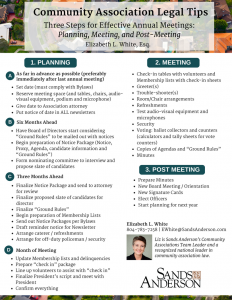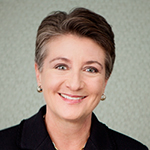Tips from our Community Associations Team
 Click to download list in PDF format
Click to download list in PDF format
1. Planning
A. As far in advance as possible (preferably immediately after last annual meeting).
- Set date (must comply with Bylaws)
- Reserve meeting space (and tables, chairs, audio-visual equipment, podium and microphone)
- Give date to Association attorney
- Put notice of date in ALL newsletters
B. Six Months Ahead
- Have Board of Directors start considering “Ground Rules” to be mailed out with notices
- Begin preparation of Notice Package (Notice, Proxy, Agenda, candidate information and “Ground Rules”)
- Form nominating committee to interview and propose slate of candidates
C. Three Months Ahead
- Finalize Notice Package and send to attorney for review
- Finalize proposed slate of candidates for director
- Finalize “Ground Rules”
- Begin preparation of Membership Lists
- Send out Notice Packages per Bylaws
- Draft reminder notice for Newsletter
- Arrange caterer / refreshments
- Arrange for off-duty policeman / security
D. Month of Meeting
- Update Membership lists and delinquencies
- Prepare “check in” package
- Line up volunteers to assist with “check in”
- Finalize President’s script and meet with President
- Confirm everything
2. Meeting
- Check-in tables with volunteers and Membership lists with check-in sheets
- Greeter(s)
- Trouble-shooter(s)
- Room/Chair arrangements
- Refreshments
- Test audio-visual equipment and microphones
- Security
- Voting: ballot collectors and counters (calculators and tally sheets for vote counters)
- Copies of Agendas and “Ground Rules”
- Minutes
3. Post Meeting
- Prepare Minutes
- New Board Meeting / Orientation
- New Signature Cards
- Elect Officers
- Start planning for next year
Elizabeth L. White is Sands Anderson’s Community Associations Team Leader and a recognized national leader in community association law. Her practice is centered on acting as general counsel to large-scale master planned communities, as well as representing developers, financial institutions, local governments and insurers in connection with planned community developments, condominiums and operations.
